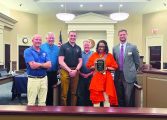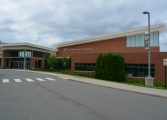Bobby Popowicz, originally from Caroline County, now heads up the newly formed department along with Senior Planner Allyson Finchum. Both are familiar with rural areas as well as urban and suburban communities.
Popowocz, a former Board of Supervisors member in Caroline County and the liaison to the revamped Economic Development Program and a former member of the Economic Development Team, sees many possibilities and untapped resources in Fluvanna.
He explained that in Caroline County, they had similar issues as the ones facing Fluvanna. The economic development team was instrumental in planning for the future and its members came from a variety of county, state and government entities, including county administration, planning, schools and utilities. He thinks the same success they had accomplished in Caroline County can be done here in Fluvanna by using the same model.
Finchum, who is replacing Darren Coffey is on board with many of Popowicz ideas. Both agree the first order of business is to explore ways to bring water to the area and build an infrastructure to support economic development.
“Without a water infrastructure we will not move far,” said Popowicz. Recently, he spoke with the Fluvanna Chamber of Commerce and the Board of Supervisors regarding setting goals to move Fluvanna forward. Among the short term goals were entertainment and event tourism. One idea is a folk festival. He cautions these are only short-term goals and not a long range revenue source.
He said that festivals are fairly easy to recruit, need a lot of land, require heavy advertising inside and outside Fluvanna’s borders and need to partner with others. Along with this idea is an entertainment park but this too requires intensive recruitment, large parcels of land, a community buy-in as well as intensive studies by investors and cooperation with state agencies.
“The short term recruitment strategy is to focus on entertainment tourism, which will give quick returns and allow Fluvanna to plan for mid and long term strategies,” he said.
Heritage tourism has been bandied about in the past few years as a way to bring in some revenue. Popowicz points out that it requires intensive background research and it’s a slow starter requiring intensive advertising and other points of interest. He said that it gives a sense of community for other recruitment.
Among events that have been successful in Fluvanna have been agricultural-tourism events including Farm Day and the wine festival and the heavily advertised Barbecue, Bands and Brews. He said this requires unique themes and creative advertising or a proven business model such as a winery or brewery. He said this too is dependent upon advertising and regional cooperation. This can also be done in conjunction with entertainment tourism and does not disturb the rural landscape.
He discussed the role of restaurant and retail, something that residents think will boost county revenue like the Wal-Mart in Louisa. However, Popowicz is again guarded on the subject, citing the fact that this requires large population densities or employment centers, light industrial and office parks. It also requires investment studies, population or traffic population density studies to determine feasibility and willing investors. When asked about the proposed retail across from E W Thomas, he stated it was on hold and pending Virginia Department of Transportation’s decision regarding the area roads.
“Retail and restaurant businesses are cyclical in nature, dependent on the highs in the economy.” He adds these types of businesses naturally occur in legacy project and employment centers.
Popowicz believes that once an infrastructure is established to allow business to grow then Fluvanna can recruit businesses to locate here.
“We have a great location, close to Charlottesville and Richmond. We have an underutilized road infrastructure and access to the interstate and we have no BPOL or meals tax,” he said. To entice business to come here, investment in infrastructure is the priority and then intense recruitment. He adds this will entail having willing investors and shovel ready locations. Other incentives would be tax rebates, easy processing of applications and location considerations.
“Recruitment to inception takes up to three years,” he said.
Another more unconventional approach are legacy projects, which are multi-faceted in nature requiring community involvement and may take upwards to 20-25 years to develop. Legacy projects call for long range planning and special investors and feature different types of zoning and dedicated partners from the public and private sectors.
“We can no longer throw things on the wall and see how they stick,” he said. “A targeted approach will need to be deployed in order to keep the county character without turning it into a bedroom community. Sustainability is key. We need to attract certain businesses that bring a sustainable tax base without bringing extra population.”
He discussed the Rockingham County model.
“These are large businesses grouped in the eastern and central part of that county, including Honeywell, Bantam Books, Coors, Perdue, Pilgrim’s Pride, Crown Door and others are all in Rockingham,” he said. Rockingham County is mostly rural and large retail centers are concentrated in the city of Harrisonburg.
He explained that Fluvanna needs to attract businesses like research and development, data centers, agricultural businesses as well as using the employment center approach by bringing in larger facilities with 200-500 employees to Zion Crossroads and centralize business growth that is sustainable.
“A good example would be Yahoo,” he added. The Legacy Project is another varied business idea, gaining momentum these days by centralizing business in mixed use developments.
On the other side of the coin is planner Finchum, who graduated from American University with degree in communications with a minor in graphic design. Finchum admits it was graphic design that led her to a career in planning.
“Working for Prince William County doing their maps and displays I became interested in planning,” she said. “It combines so many different areas including architecture, law, historical preservation and all those areas are incorporated into a community.” Like Popowicz, her enthusiasm and passion for what she does is evident. She brings with her diverse experiences, in topics ranging from historical preservation, to transportation and zoning to long-range planning and planning review.
“I wanted to make sure I wasn’t pigeonholed into one area,” she said.
Finchum said, “We need to look at all sides of an issue and work together to find some common ground, nothing negatively affecting any one group. Listening to the residents helps me to understand their concerns.”
She stated there are other options to bring water to the county other than the one that suggest a partnership with Aqua Virginia, including withdrawing water from the James River. Her concerns with Aqua Virginia is the rate increases, which she knew of firsthand in Caroline County.
Finchum adds that looking at Louisa’s development of Zion Crossroads may yield some answers for Fluvanna.
“We need to plan for a profitable development and one that will not burden tax payers,” she said. As for developments, Finchum is looking into the cash proffers for residential growth.
Looking at the demographics, she recognized the changes taking place and that there has been an increase in the number of school age children in Fluvanna. This and other factors will affect planning in the future.
Storm water management is also an issue. “We will have to have a drafted storm water management plan by 2014. There are new regulations and state mandates we have to implement. This is the perfect time to work with areas including Lake Monticello on a plan,” she said.
Another idea to get the community involved is charrettes, which are intense periods of design activity.
“A diverse group of people, planners, architects, and others come together for a couple of days, marking maps and talking with the public who are also welcome to mark up the maps. While the public comes in over a few days, the team of experts works on a plan to present to the public.” She likes this idea as a tool to reach Fluvanna residents.
Both Popowicz and Finchum agree that sustainability, balance, keeping Fluvanna’s rural character intact and increasing the tax base without adding extra services or burdens on taxpayers is the priority.




